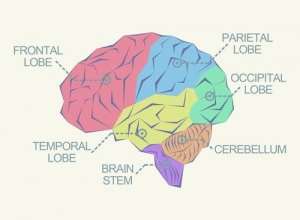What Are the Different Lobes of the Brain?


Written and verified by the doctor Leonardo Biolatto
The lobes of the brain are the areas that the cortex of the brain is divided into, according to the functions they perform. In other words, the different lobes of the brain are a functional and anatomical division of the brain. In addition, this division helps us identify the origins of each of our functions as human beings.
You might like: Four Ways Depression Affects Your Brain
It’s actually pretty easy to see the divisions in the brain at just a glance, especially the two hemispheres since there are grooves that clearly divide them. However, within each hemisphere, you can also find slightly differentiated areas thanks to other fissures and grooves.
From studying the lobes of the brain, we can understand that each one fulfills a series of specific tasks. For example, the frontal lobe controls things like emotions and our capacity for reasoning, among other things.
As a result, scientists claim that there are six lobes of the brain. These are the frontal, parietal, temporal, occipital, limbic, and insular lobes. In this article, you’ll learn everything you need to know about them.
How are the lobes of the brain divided?
As we’ve already mentioned, the lobes of the brain are first defined anatomically. This means that each one is located in a specific part of the brain. The divisions between these areas consist of grooves and fissures that are normally present within this organ.
First, the frontal lobe is located in the front part of the brain. As the name suggests, it is located behind the frontal bone of the skull. Additionally, it’s one of the largest lobes of the brain.
On the other end, we find the occipital lobe. It’s located at the back of the skull, near the neck. Between this lobe and the frontal lobe is the parietal lobe. In addition, it’s important to know that the temporal lobes are the ones located near the temples, also between the frontal and the occipital lobes.
However, it doesn’t end here. The location of certain brain lobes, such as the insula and the limbic, is slightly more complex. The insular lobe is slightly hidden behind the temporal lobe. The limbic lobe crosses through the junctions of the frontal, parietal and temporal lobe.
What are the functions of the brain lobes?
Although it isn’t an exact, millimetric division, it’s widely accepted that functions such as language, movement, or reasoning are distributed among each of the lobes of the brain.

Frontal lobe
This part of the brain seems to be related to personality and decision making. It intervenes in impulse control and in social and sexual behavior. In fact, scientists believe that emotions begin in this area.
Parietal lobe
Out of all the lobes of the brain, the parietal is the one that’s most involved in information processing. In addition, it’s essential for obtaining spacial information. In other words, it allows us to identify the size, shape, and distance of objects.
It also seems that the parietal lobe intervenes in the understanding of written language. Researchers also claim that this lobe gives us the ability to solve mathematical problems, among other things.
Temporal lobes
The temporal lobes deal with language and auditory memory. In addition, they also come into play when it comes to facial recognition and speech comprehension. In other words, this is the lobe that is most closely related to the auditory system. As a result, it’s also the one most affected by epileptic disorders.
Occipital lobe
This lobe is of the greatest importance when it comes to the sense of sight. It’s responsible for interpreting and recognizing images. In the same way, the occipital lobe allows us to discriminate both color and movement and also serves for spacial recognition.
You might like: The Best Tips for Having a Young, Vital Brain
Other lobes of the brain: the insula and the limbic lobe
The insula works by integrating information from different systems of our body. It intervenes in numerous emotional processes, in taste, smell, and so on. In fact, this is the lobe that’s most closely related to pain perception and empathy.
The limbic lobe is primarily responsible for the ‘sense of survival’. It’s linked to numerous functions such as hunger, sexual instinct, memory, and even attention span.
In conclusion
Our brain is one of the most complex structures in existence. Studying the lobes of the brain allows us to further our knowledge and identify the parts and functions of the brain. In the future, this will help us establish better treatments and diagnoses.
All cited sources were thoroughly reviewed by our team to ensure their quality, reliability, currency, and validity. The bibliography of this article was considered reliable and of academic or scientific accuracy.
- MacLean, P. D. (1990). The triune brain in evolution : role in paleocerebral functions. Plenum Press. Retrieved from https://books.google.es/books?hl=es&lr=&id=4PmLFmNdHL0C&oi=fnd&pg=PA1&dq=MacLean,+P.D.,+“The+Triune+Brain+in+Evolution:+Role+in+paleocerebra+functions&ots=y8ofFp_V43&sig=CW0ZXWMRagoBt0sqREuxsYODpjU&redir_esc=y#v=onepage&q=MacLean%2C P.D.%2C “The Triune Brain in Evolution%3A Role in paleocerebra functions&f=false
- Lóbulo temporal: características, anatomía y funciones – Lifeder. (n.d.). Retrieved September 27, 2019, from https://www.lifeder.com/lobulo-temporal/
- Shura, R. D., Hurley, R. A., & Taber, K. H. (2014). Insular Cortex: Structural and Functional Neuroanatomy. The Journal of Neuropsychiatry and Clinical Neurosciences, 26(4), iv-282. https://doi.org/10.1176/appi.neuropsych.260401
- Lobulo frontal | CNS Traumatic Brain Injury Rehabilitation. (n.d.). Retrieved September 27, 2019, from https://www.neuroskills.com/language/espanol/lobulo-frontal/
This text is provided for informational purposes only and does not replace consultation with a professional. If in doubt, consult your specialist.









